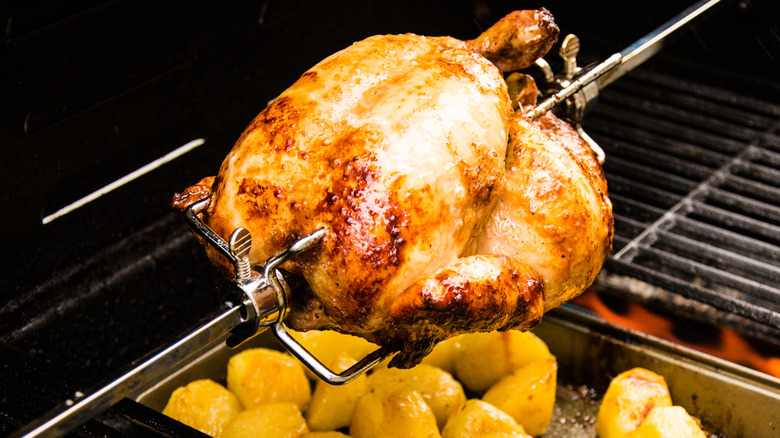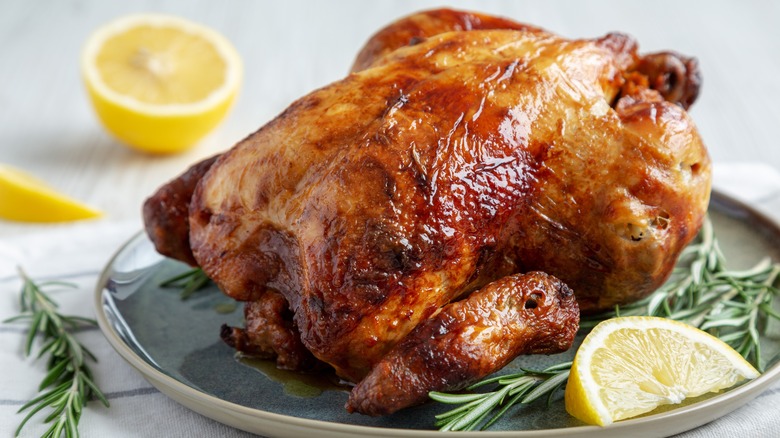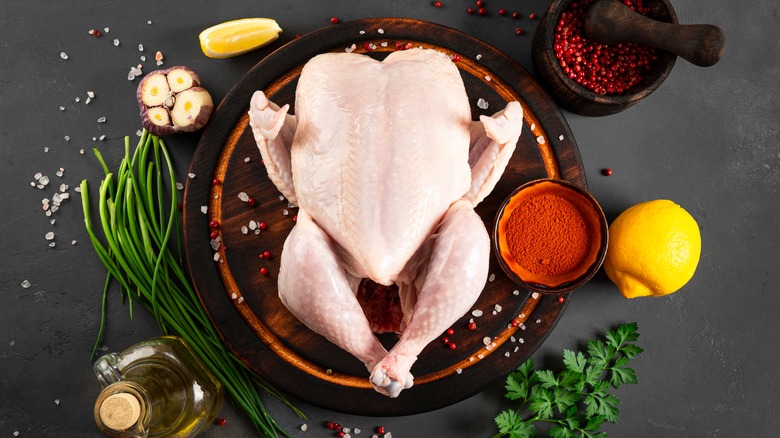Ditch The Grocery Store And Start Cooking Rotisserie Chicken On The Grill
Rotisserie chickens are a cherished part of many household meal rotations because of their savory flavor and succulent meat. Yes, many people pick up a bird from Costco for $4.99 for the ease and convenience of a pre-made main, but it's the taste that keeps people coming back. As the summer season begins, there's no better time to consider making your own version of the grocery store item using your grill.
Setting up a spit isn't nearly as hard as it sounds. Plus, cooking a juicy piece of meat outside ensures there's less mess to wipe up from your oven and counters. Home chefs can rig up the hanging rotisserie mechanism and use the forks on the rod to secure the bird. Then, close the top of the grill and trust the steady heat to permeate. The result is tender flesh and crisp skin that will outshine the wrinkled chickens at the store.
To make the food at home, you'll need a motorized rotating spit rotisserie attachment, which can be found at a hardware store if it didn't come with your grill. You'll also need to use kitchen twine to truss the bird, just like they do at the grocery store. Then, settle into the usual roasted chicken routine. Some cooks prefer to heat their gas grills nice and hot to crisp the skin before settling into a low-and-slow afternoon cook, while others, like those using a coal grill, may maintain a single steady temperature for an hour or two.
Tips for roasting your bird
Before you embark on a grilling adventure, make sure your bird is centered and balanced across the rotisserie rod. This will ensure the spinner can do its job. And check those wing tips are tucked before you get going, as they will dry or burn. Coal users may find this is a great time to test out indirect heat, too, and they can bank coals to one side to heat the poultry as it rotates.
Set up your station with a piece of foil or a tin roasting pan underneath the chicken to catch any drippings. This helps prevent stray flares and reduces the mess even further. You can fill the drip pan with water for moisture, or add seasonal produce to flavor the falling fat for a future sauce. For an extra aromatic dinner and smoky leftover chicken salads, toss a chunk of aromatic wood onto the coals, too.
If the rotating spit is challenging to track down, you can follow the same tactics to make beer can chicken on the grill, but it won't have the same golden sheen across every inch. Air fryer users can also use their machines as a shortcut to crispy skin, but diners may not encounter the same char and charm imparted by the outdoor setup. Regardless of how it's cooked, make sure to test the temperature (after halting any spinning mechanisms) with a digital thermometer before turning off the heat and letting the meat rest.
Seasoning homemade rotisserie chicken
Another winning point for homemade rotisseries is that their flavor is utterly up to you, as is their sodium content. For people on low-sodium diets, it's easy to control how much salt goes into the savory food, and those sensitive to herbs can adjust their seasonings of choice. You could make the dish slightly sweeter with a barbecue sauce glaze or a spicy cajun rub to finish the rotating meal.
To achieve moist breasts and thighs, consider taking advantage of an overnight brine. Use buttermilk or the traditional saltwater mixture to ensure the meat is truly tender. Brining can infuse flavor beneath the skin, so consider adding aromatics like garlic and citrus to the soak.
After it's prepared for the grill, give your project extra time to sit in the fridge uncovered. Allowing the skin to air dry encourages maximum golden crispness — though it'll reach an even deeper hue if basted with fat while it cooks. And don't forget to coat the chicken with a generous amount of pepper, paprika, onion powder, fennel, dried oregano, and any other favorite spices. Cooks can, of course, buy a dedicated rotisserie chicken rub to mimic the store-bought taste, but it's fun to personalize the culinary project to your diners' palates.



